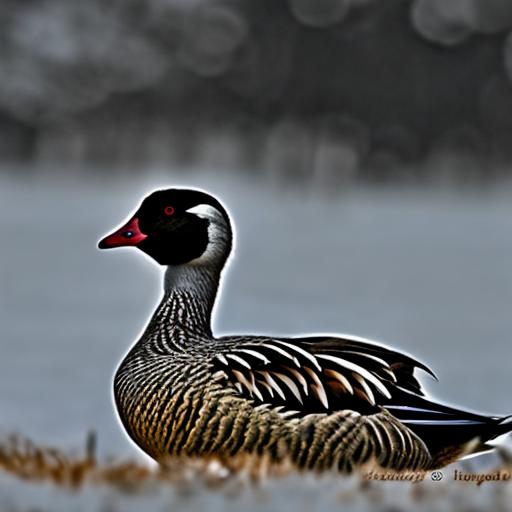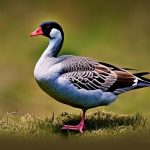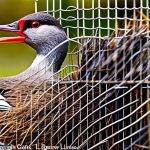Warm feet are crucial for the survival and well-being of geese, as they spend a significant amount of time on their feet, whether it’s foraging for food, nesting, or roosting. The ability to maintain warm feet is essential for their overall health and ability to thrive in their natural habitat. Without warm feet, geese would struggle to regulate their body temperature, leading to potential health issues and decreased chances of survival. Additionally, warm feet are essential for maintaining proper blood circulation, which is vital for overall health and well-being. Therefore, the importance of warm feet cannot be overstated when it comes to the survival and thriving of geese in their natural environment.
Geese rely on their feet for various activities such as walking, swimming, and even flying. Without warm feet, these activities would become challenging and could potentially lead to decreased mobility and overall fitness. Furthermore, warm feet are essential for maintaining proper balance and stability, which is crucial for geese to navigate their surroundings and avoid potential predators. In essence, warm feet are not only important for the physical health of geese but also for their ability to carry out essential activities that are necessary for their survival. Therefore, understanding the natural insulation, blood circulation, and behavioral adaptations related to warm feet in geese is crucial for ensuring their well-being and conservation in the wild.
Key Takeaways
- Warm feet are crucial for geese to maintain their overall health and well-being.
- Geese have natural insulation on their feet, which helps them stay warm in cold environments.
- Efficient blood circulation in geese feet is essential for maintaining warmth and preventing frostbite.
- Geese have behavioral adaptations such as tucking their feet under their feathers to keep them warm.
- Nesting and roosting habits play a significant role in protecting geese feet from extreme temperatures.
- Geese experience seasonal changes in their feet, with adaptations for both cold and warm weather.
- Human impacts, such as habitat destruction and pollution, can negatively affect the warmth and health of geese feet.
Natural Insulation on Geese Feet
Geese have evolved to have natural insulation on their feet to help them maintain warmth in cold environments. The insulation is provided by a thick layer of feathers and down that cover the entire foot, including the webbed portion between the toes. This natural insulation acts as a barrier against the cold, preventing heat loss from the feet and helping to maintain a comfortable temperature. The feathers and down also provide a cushioning effect, which helps protect the feet from rough terrain and potential injuries.
The natural insulation on geese feet is an adaptation that has evolved over time to help them survive in their natural habitat, where they are often exposed to cold temperatures and harsh weather conditions. This adaptation allows geese to continue their daily activities without being hindered by the cold, ensuring that they can forage for food, nest, and roost without discomfort or risk of frostbite. The natural insulation on geese feet is a remarkable example of how animals have adapted to their environment, allowing them to thrive in conditions that would be challenging for many other species.
Blood Circulation in Geese Feet
Proper blood circulation is essential for maintaining warm feet in geese. The circulatory system in geese feet plays a crucial role in regulating body temperature and ensuring that the feet remain warm even in cold environments. Geese have a specialized circulatory system in their feet that helps them conserve heat and maintain warmth. The arteries in their feet are surrounded by veins, creating a counter-current heat exchange system that helps retain heat and prevent excessive heat loss from the feet.
This specialized circulatory system allows geese to regulate the temperature of their feet by controlling the flow of warm blood to the extremities and minimizing heat loss to the environment. As a result, geese are able to maintain warm feet even in freezing temperatures, allowing them to continue their daily activities without being hindered by the cold. The efficient blood circulation in geese feet is a remarkable adaptation that allows them to thrive in their natural habitat and highlights the incredible resilience of these birds.
Behavioral Adaptations for Warm Feet
In addition to natural insulation and efficient blood circulation, geese have also developed behavioral adaptations to help maintain warm feet. One such adaptation is the habit of tucking one foot up into their feathers while standing on the other foot. This behavior helps reduce heat loss from the exposed foot by minimizing its contact with the cold ground or water. By alternating which foot is tucked up, geese are able to keep both feet warm without exerting excessive energy.
Another behavioral adaptation for warm feet is the practice of roosting in groups. When geese roost together, they huddle closely to share body heat, which helps keep their feet warm during cold nights. This communal roosting behavior allows geese to conserve energy and maintain warmth without relying solely on their natural insulation and circulatory system. By working together, geese are able to ensure that each member of the group stays warm and comfortable, even in challenging weather conditions.
Nesting and Roosting Habits
Nesting and roosting habits also play a significant role in helping geese maintain warm feet. When nesting, geese build their nests with insulating materials such as feathers, down, and grass, creating a cozy environment that helps keep their feet warm while incubating eggs. The insulating properties of the nest help prevent heat loss from the feet and provide a comfortable space for the geese to rest and keep their eggs warm.
During roosting, geese often choose sheltered locations such as marshes, wetlands, or open fields where they can huddle together for warmth. By roosting in sheltered areas, geese can minimize exposure to cold winds and other elements that could cause heat loss from their feet. Additionally, roosting in groups allows geese to share body heat and maintain warmth throughout the night, ensuring that their feet remain comfortable and protected from the cold.
Seasonal Changes in Geese Feet

Geese experience seasonal changes in their feet as they adapt to different environmental conditions throughout the year. During the winter months, when temperatures drop and snow covers the ground, geese rely on their natural insulation and efficient blood circulation to keep their feet warm. They may also alter their behavior by roosting in larger groups or seeking out sheltered areas to minimize exposure to cold temperatures.
In contrast, during the warmer months, geese may experience changes in their feet as they engage in activities such as nesting, foraging for food, and caring for their young. As they transition from winter to spring, geese may shed some of their down feathers as part of their annual molt, which could affect the insulation on their feet. However, they continue to rely on behavioral adaptations such as nesting and roosting habits to maintain warmth as they navigate changing environmental conditions.
Human Impacts on Geese Feet Warmth
Human impacts on geese feet warmth can be significant, especially in areas where human activities encroach on natural habitats. For example, urban development can lead to habitat loss for geese, forcing them to adapt to new environments where they may face challenges in maintaining warm feet. Additionally, pollution and environmental degradation can affect water quality and food sources for geese, potentially impacting their overall health and ability to maintain warmth.
Furthermore, human activities such as hunting and disturbance can disrupt the natural behaviors of geese, leading to increased stress and energy expenditure that could affect their ability to keep their feet warm. Conservation efforts aimed at protecting natural habitats and minimizing human impacts on geese can play a crucial role in ensuring that these birds are able to maintain warmth and thrive in their natural environment.
In conclusion, warm feet are essential for the survival and well-being of geese, as they rely on their feet for various activities such as foraging, nesting, and roosting. Natural insulation, efficient blood circulation, and behavioral adaptations all play a crucial role in helping geese maintain warmth in cold environments. Understanding the importance of warm feet and the various factors that contribute to it is essential for ensuring the conservation of these remarkable birds in the wild. By recognizing the significance of warm feet for geese and taking steps to minimize human impacts on their natural habitat, we can help ensure that these birds continue to thrive for generations to come.
If you’re interested in learning more about keeping poultry warm during the winter, you might want to check out this article on choosing the right heater for a chicken coop. Just like geese, chickens also need proper care and attention to stay warm and comfortable in colder temperatures. This article provides valuable insights into selecting the best heating options for your chicken coop, ensuring the well-being of your feathered friends during the chilly months.
Meet Walter, the feathered-friend fanatic of Florida! Nestled in the sunshine state, Walter struts through life with his feathered companions, clucking his way to happiness. With a coop that’s fancier than a five-star hotel, he’s the Don Juan of the chicken world. When he’s not teaching his hens to do the cha-cha, you’ll find him in a heated debate with his prized rooster, Sir Clucks-a-Lot. Walter’s poultry passion is no yolk; he’s the sunny-side-up guy you never knew you needed in your flock of friends!







